Ever since that first visit, I’ve returned to my favorite city in the world year after year to continue exploring and immersing myself in its vibrant energy. Bangkok has become a second home to me and I’m excited to share all of my insider tips with you!
From its ornate temples that transport you to another time, to its bustling markets where you can find everything from unique handicrafts to mouthwatering street food, Bangkok is a treasure trove of unforgettable experiences. With this itinerary, I’ll help you see the best of Bangkok.
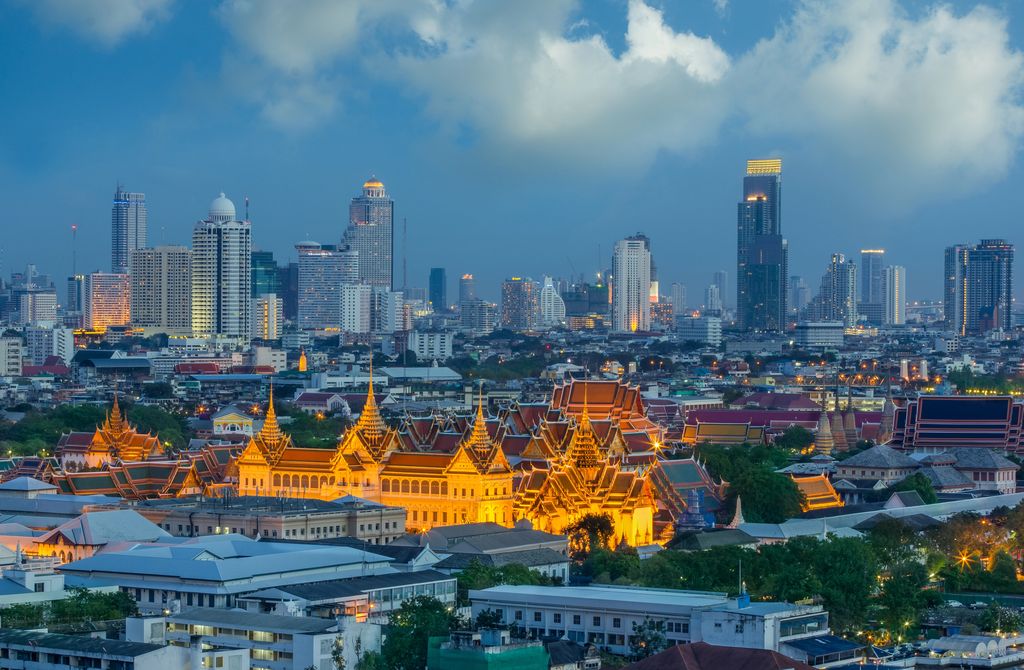
Itinerary at a glance
I’ve written this guide as a 4-day itinerary for Bangkok, though I’ve prioritized the must-see sights for Day 1 and Day 2, so you can use this as a template no matter how long you’re staying in Bangkok.
We’ll start with the essentials inside the city and then work our way to some amazing day trips outside of Bangkok.
| Day | Activities |
| 1 | Visit the temples, Visit the Bangkok Flower Market, See the sunset at Wat Saket, Explore a night market |
| 2 | Visit the Maeklong Railway Market and cruise through a Floating Market, Watch a Muay Thai match, Visit a rooftop bar |
| Alternative on day 2: Check out Khlong Toei Market | |
| 3 | Stroll through Bangkok’s parks, Shop at Chatuchak Weekend Market, Explore Chinatown and the Talad Noi District (Option: Chinatown night tour) |
| Alternative on day 3: Take a tour to the Ayutthaya | |
| 4 | Visit Jim Thompson House, Shop at Siam Square, Party on Khao San Road, Take a cruise on the Chao Phraya River |
| Extra time | Join a cooking class, Visit Erawan Museum, See Asiatique, Visit Bang Krachao, Tour at Kanchanaburi |
Things to Know before arrival
Before we get into all of the juicy details of what to do and see in Bangkok, there are some basics we need to cover first. If you wish, you can scroll ahead to Day 1 of this itinerary to skip the practical tips.
Getting to Bangkok from the Airport
Bangkok has two airports. If you are flying in internationally, then you will most likely land at Suvarnabhumi Airport (BKK). The smaller Don Mueang Airport (DMK) deals more with domestic and regional flights.
There are several options for getting into downtown Bangkok:
By Taxi
The most convenient, albeit pricier, transportation option. Once you exit the Arrivals Hall, you’ll find taxis readily available, and the process is well-organized.
Simply take a number and wait in line for the next available taxi. It’s a hassle-free way to reach your accommodation and you won’t have to worry about any potential misunderstandings with your driver.
While fares vary depending on your final destination, you can expect to pay approximately 400-500 baht for your ride.
By Train
The best option (in my opinion) is to take the Airport Rail Link. This is a train that runs from Suvarnabhumi Airport to Phaya Thai Station. It departs frequently, is clean, and best of all costs less than $1.00.
From Phaya Thai Station, you can hop directly on the Sukhumvit BTS (Bangkok Sky Train) Line. If you need the MRT (subway), you’ll want to get off at Makkasan Station.
Or, once you get off the Airport Rail Link, you could grab a taxi, or even a tuk-tuk if you want to start your visit off in the most fun way possible.
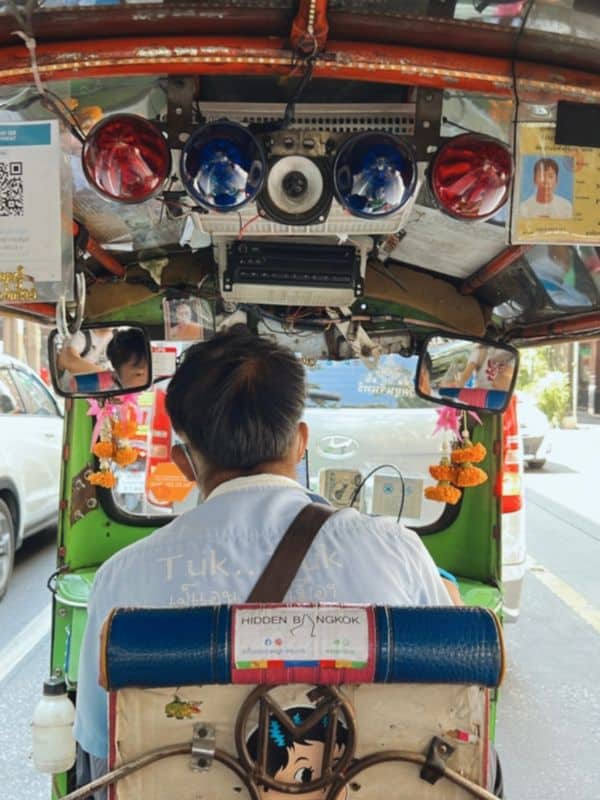
Choosing Your Travel Dates
Allow me to let you in on a little secret: timing is everything when it comes to experiencing the best of Bangkok.
Not all of Bangkok’s main attractions are open every day of the week! Many of the highlights like the floating markets and Chatuchak Weekend Market are only, you guessed it, open on the weekend.
For this reason, I recommend trying to plan your Bangkok itinerary to overlap with the weekend. Of course, I realize that’s not always possible, which is why I’ve provided some additional suggestions for Bangkok activities if the dates don’t line up for your trip.
How Many Days in Bangkok
Many people choose to spend only one or two days in Bangkok, but two days will be hectic and give you just a quick overview.
Depending on your interests, budget, and time, I feel 4 days in Bangkok is the ideal amount for exploring the city center and having time for at least one day trip outside of the city.
For a more in-depth experience, you could easily spend five to seven days in the city (or more). Still, you would barely even scratch the surface!
In the event that you do have a few extra days to spare in Bangkok, I’ve provided some additional activities that you can add to your itinerary toward the end of this post.
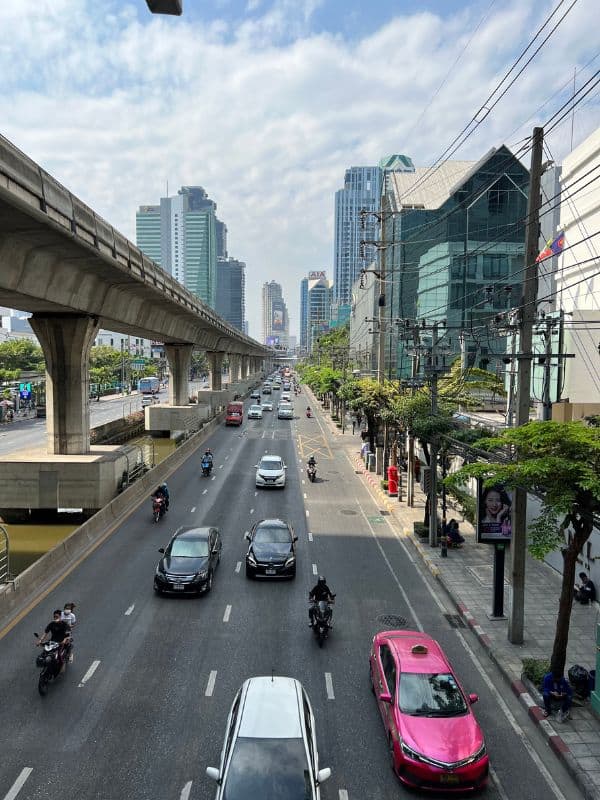
How Much Money Should I Bring to Bangkok?
In Bangkok, you can really spend as much or as little as you please.
Are you seeking budget-friendly accommodations, with hostels available for as low as $15 per night? (See Bangkok hostels here.) Or are you looking to indulge in a luxurious stay at a high-end hotel?
When it comes to dining, are you more inclined to eat among locals at a bustling market, or would you prefer to delve into the city’s fine dining scene?
Of course, finding the perfect balance between the two extremes is also an option, allowing you to enjoy the best of both worlds.
To give you a general idea of costs, on my recent trip to Bangkok in February 2023, my partner and I spent an average of 1,410 baht ($40.67 USD) per day. This does not include the cost of our accommodation, but does include daily meals, massages, snacks, transportation, souvenirs, and activities.
We rarely ate at sit-down restaurants, as we prefer to eat at the local markets. However, good, quality coffee is a priority for us, so we “splurged” multiple times on the finest coffee in the city (about 120 baht, or $3.46, for a caffe latte at a specialty coffee shop like Flâneur).
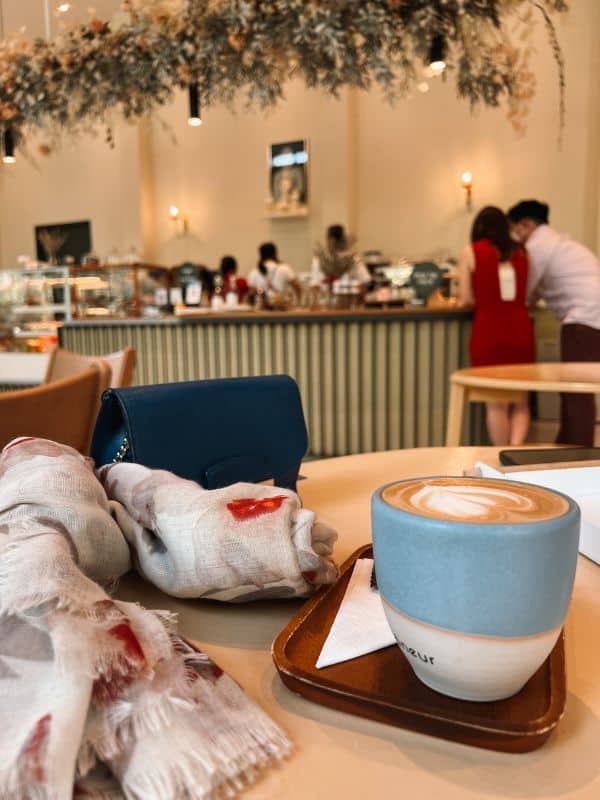
According to Budget Your Trip, the average daily cost of traveling in Bangkok is around 2,666 baht ($79) per person, which includes expenses like meals, transportation, and activities. As far as accommodation goes, the average hotel price for a couple in Bangkok is 2,899 baht ($85) per night.
Bangkok is a city of many levels, so there isn’t a “standard” amount of money you should bring. Nevertheless, the above should give you a good starting point to calculate a budget that suits you.
Staying Connected in Bangkok
If you don’t already have an international cellphone plan, then you’ll definitely want to get a SIM card once you’re in Bangkok.
Not only will you be able to access apps like Google Maps and Grab (Thailand’s version of Uber), but you will successfully avoid high roaming charges and slow overseas data plans.
The two main providers in Thailand offering tourist SIM Cards are True and AIS. I have one from True, but both companies offer 5G and affordable data packages.
For example, you can get 15 days of unlimited 5G internet and call from True for 699 baht ($20). If you end up needing more, you can top up at any 7/11 convenience store.
The best place to get a SIM card is at the airport before you actually leave the airport. Yes, the prices might be slightly more expensive than in the city, but doing it here can save you the time and hassle of searching for a place to buy a SIM card in the city.
As soon as you pass through passport control and reach the arrival area of Suvarnabhumi Airport, you’ll immediately see kiosks lined up where you can purchase a SIM card.
4 Days in Bangkok Itinerary
Day 1 in Bangkok
Visit the Temples
Start your 4-day Bangkok trip with a temple tour!
There are over 400 temples in Bangkok alone, but don’t worry, you’ll only be visiting the most famous ones (unless of course, you want to see more, then by all means, go for it!).
The most impressive temples include Wat Pho, Wat Arun, and Wat Phra Kaew (Temple of the Emerald Buddha), located inside the Grand Palace.
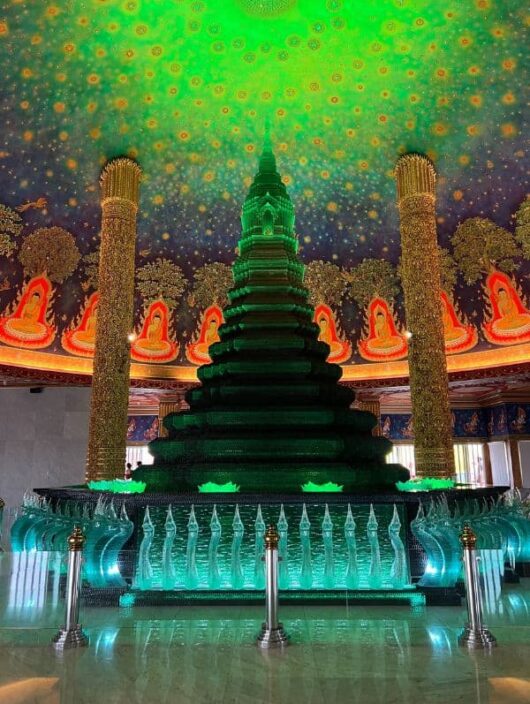
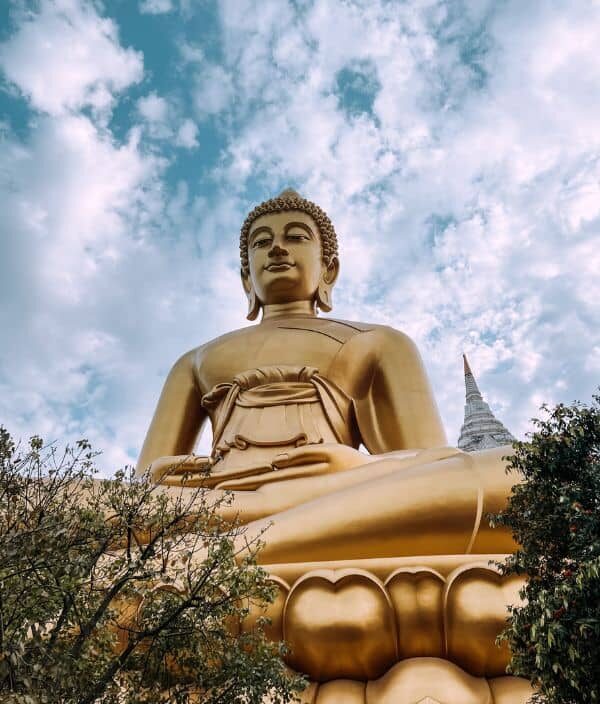
To make the most of your temple visits, consider joining a guided tour or hiring a knowledgeable local guide who can provide insights into the history, legends, and cultural significance of at least one temple. They can enhance your experience by sharing fascinating stories and anecdotes that you wouldn’t otherwise be able to find on your own.
Temple etiquette
Remember that most temples have a dress code and you should carefully choose what to wear when visiting Thailand temples.
Women are expected to cover their shoulders and knees, so it’s a good idea to have something like a sarong or shawl that you can use to cover up appropriately. Men can wear t-shirts and can usually get away with knee-length shorts.
You will likely be required to remove your shoes, so you may wish to wear something that is easy to slip on and off.
If you don’t like walking barefoot, you may want to carry a pair of socks to wear inside the temples. Some temples, like Wat Pho, will give you a reusable bag to put your shoes in and carry with you as you walk through the temple.
Wat Arun Ratchawararam (Temple of Dawn)
I recommend getting up early on your first day and arriving at your first stop, Wat Arun, by 8:00 AM (opening time).
This is for two reasons: the first is that the outside temperature will be pleasant, allowing you to comfortably roam around the temple grounds. The second reason is that arriving early will ensure you beat the crowds of tourists.
Nestled on the banks of the Chao Phraya River in Bangkok, stands the magnificent Wat Arun (map pin). With a history dating back over 300 years, this iconic temple showcases the captivating Khmer-style architecture that has enchanted visitors for centuries. It is certainly one of the most beautiful temples in the city, and my personal favorite!
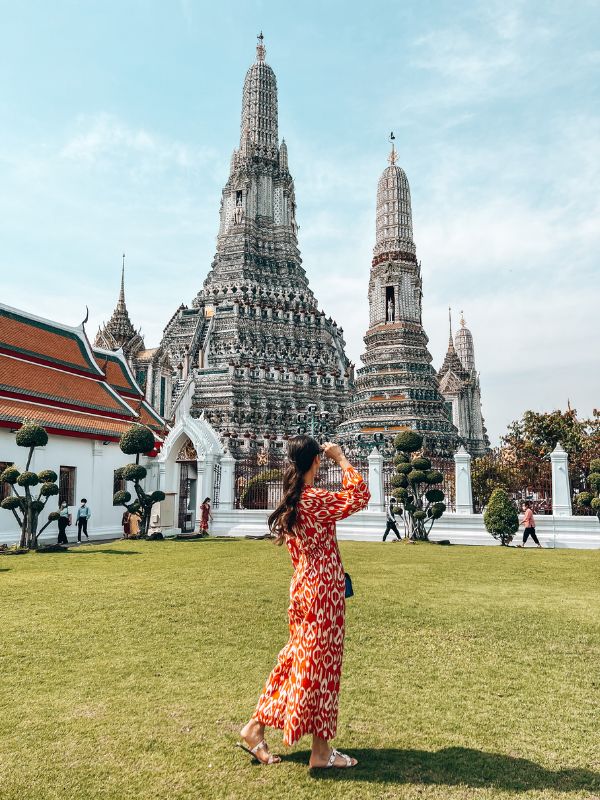
At the heart of Wat Arun is its towering spire, Phra Pang, which soars above 70 meters in height. It’s hard to believe that up until recently, visitors were allowed to climb the steep staircase all the way to the top!
Climbing the spire is now strictly forbidden, but you can still take the stairs to the middle level of the grand pagoda where you’ll be rewarded with stunning views of the Chao Phraya River and Grand Palace.
What truly sets Wat Arun apart from the rest of the temples you’ll visit in Bangkok is the intricate and ornate decoration adorning the spires. Covered in a mosaic of tiny seashells, beautiful colored glass, and porcelain, the temple glimmers in the sunlight creating a picture-perfect scene that has made Wat Arun a popular Instagram spot in the city.
Plan to spend about 1 hour at Wat Arun.
Taking the ferry
Tip: Wat Arun is on the west side of the Chao Phraya River. Since you will most likely be staying on the east side of the river, you can ride the Chao Phraya Express Boat to the other side to reach Wat Arun. The Chao Phraya Express is a cheap commuter ferry that transports passengers up and down the river for just 15 baht ($0.45) per ride.
The Grand Palace & Temple of the Emerald Buddha
After admiring the brilliant architecture of Wat Arun, it’s time to cross the river to visit the crown jewel of Bangkok’s historic sites, The Grand Palace (map pin).
Constructed in 1782 when King Rama I decided to make Bangkok the new capital of Siam, this Royal Thai palace is one of the must-see sights for a 4 days itinerary in Bangkok.
While the royal family no longer lives in the palace, it is still occasionally used for ceremonies (check the official website for any potential closings).
The sprawling complex is made up of several buildings, including Wat Phra Kaew (Temple of the Emerald Buddha), which houses one of Thailand’s most sacred icons. You can easily spend 2 hours inside the palace walls, marveling at the intricate structures and the Emerald Buddha.
The Grand Palace Bangkok entry fee for foreigners is 500 baht ($14.40) per person, and it is the same price for children and adults. Included are the Grand Palace, Wat Phra Kaew, and entry to the Queen Sirikit Museum of Textiles.
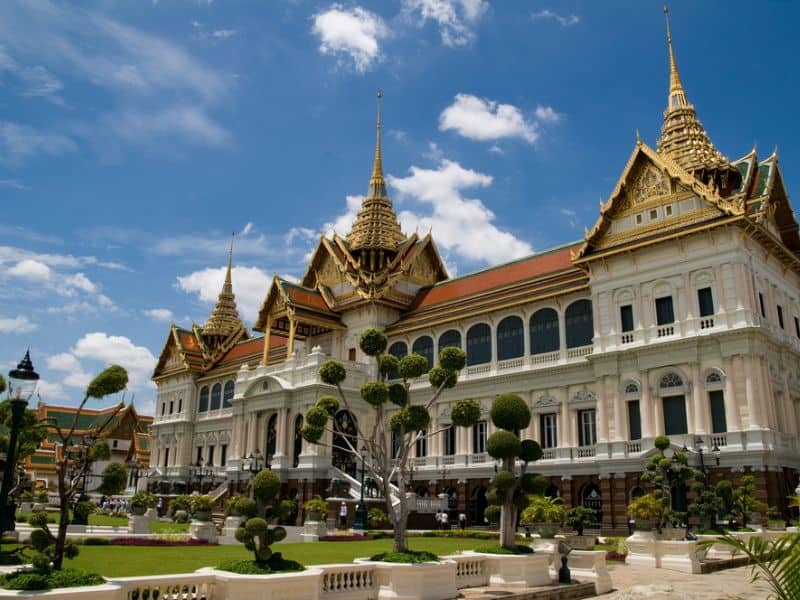
If you’re interested in exploring Bangkok’s other museums, you may want to visit the nearby Bangkok National Museum map pin(), which was the first national museum in Thailand. It is home to an extensive collection of Thai artwork and artifacts.
Additionally, the Bangkokian Museum (map pin) is a lesser-known yet interesting place to visit as the perfectly preserved 1930s home gives visitors a glimpse into the lives of the Thai middle class.
Wat Pho
From the Grand Palace, cross the street to visit Bangkok’s largest and oldest temple, Wat Pho (map pin). This temple is famous for the giant reclining Buddha which is an impressive 46-meters long (it is even more magnificent in real life!).
Take your time to wander through the temple complex, enjoy the peaceful atmosphere, and of course, admire the largest reclining Buddha statue that is completely covered in gold leaf. There are several smaller temples within the complex and various structures housing historic artifacts. Plan to spend about 1 hour at Wat Pho to properly explore it.
By now, your feet will probably be tired. Luckily, Wat Pho also serves as the national headquarters for the preservation and teaching of traditional Thai medicine and massage. Pop into the air-conditioned school to cool down and relax after all of that temple hopping.
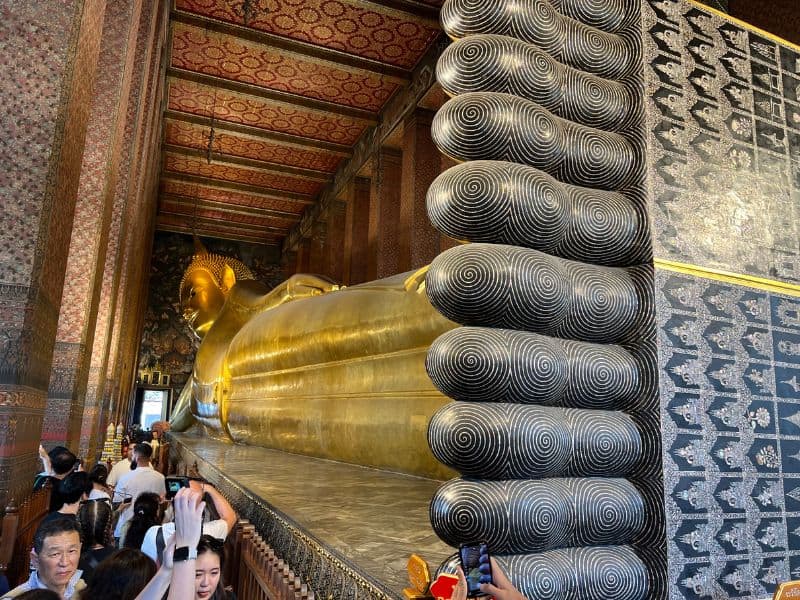
Get Your Mango Fix
For an afternoon refreshment, drop by Make Me Mango, a quirky cafe serving up fun dishes with a mango twist. You can try classics like mango sticky rice and mango smoothies, or go for something like a veggie or poke bowl (with mango of course!).
Visit the Bangkok Flower Market
Just a short 10-minute walk away from Make Me Mango is Pak Khlong Talat, Thailand’s largest wholesale Flower Market (map pin). It’s open 24 hours a day, 7 days a week, and a great place to dip your toes into a more local side of the city.
The market is both exhilarating and lively, and may initially seem chaotic, but it only adds to the charm and excitement of the experience.
Spend some time getting lost in the endless rows of roses, orchids, carnations, and miles of marigolds for the ultimate sensory adventure. You can join this guided tour to Bangkok’s flower market, which also stops at Little India.
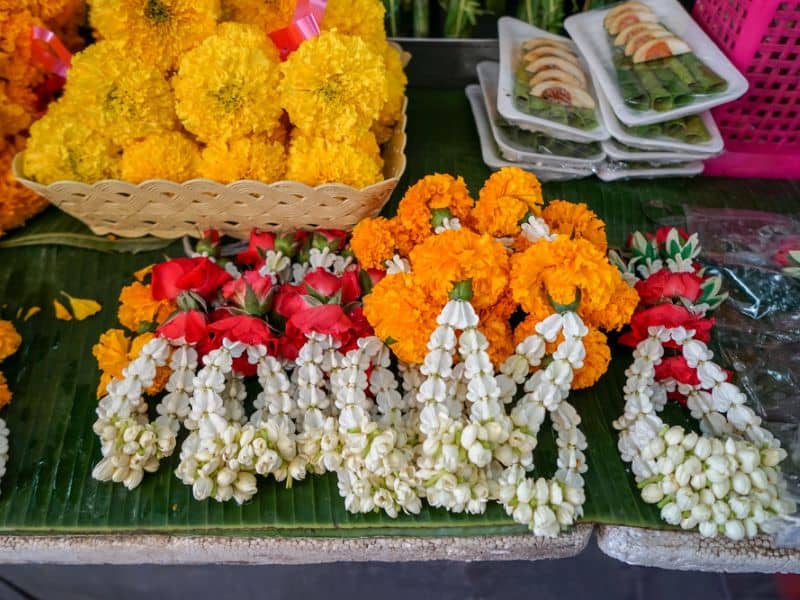
Sunset at Wat Saket (Golden Mount Temple)
Wat Saket (map pin) is one of the most dazzling and beautiful places to watch the sunset in Bangkok. The 79-meter-tall white temple stands proudly atop what is the only hill in the city. This ancient temple from the Ayutthaya period is not nearly as crowded as some of the other temples in the city, which makes visiting it extra special.
320 stairs lead you to the summit where you’ll enjoy panoramic views of Bangkok. Don’t worry though, the trail is well-paved and easy to climb up. Along the path, you’ll encounter ancient prayer bells, inviting you to ring them for a touch of good fortune on your way, and about halfway up there is a small cafe where you can enjoy a refreshment.
There’s nothing quite like sitting atop this hill as the day ends and watching the glittering lights and spires of Bangkok pass through a rainbow of colors.
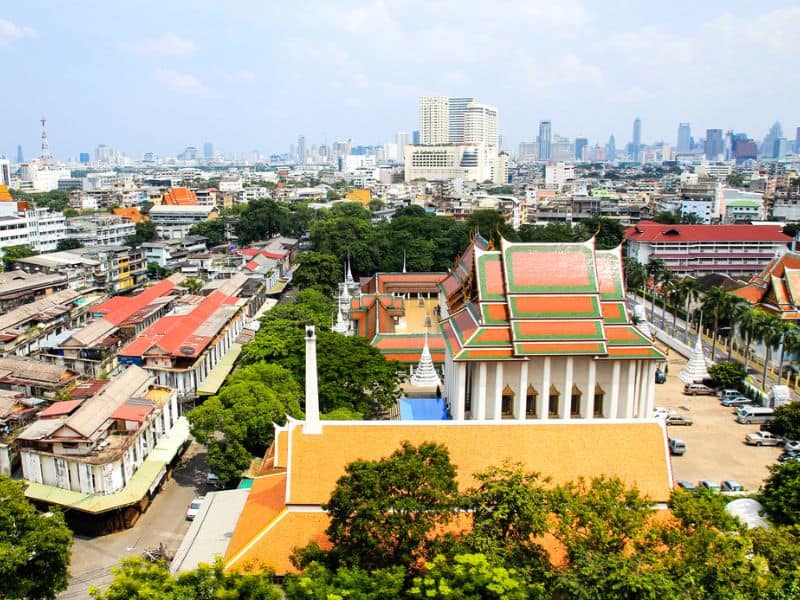
Explore a Night Market
Complete your first day in Bangkok with a visit to the Talad Rod Fai Train Night Market (map pin). The Rod Fai night market in Bangkok is an absolute must-visit for any first-time visitor to the city. Located just east of Sukhumvit Road, it’s easily accessible from the On Nut BTS station by Grab or taxi. The market usually opens around 5:00 PM and closes at midnight.
The atmosphere at the market is electric, with vintage train carriages and bright neon lights creating a quirky street-style vibe that’s unlike any other Southeast Asian night market. In addition to classic street food stalls, you’ll also find food trucks, tattoo shops, old-school barber shops, antique furniture, classic cars, and other vintage collectables.
Another great night market is the Jodd Fairs Night Market in the Rama 9 neighborhood (map pin). Here you’ll find all of your night market food classics, a section for trendy clothing and accessories, and a large seating area featuring an open-air stage where nightly performances take place.
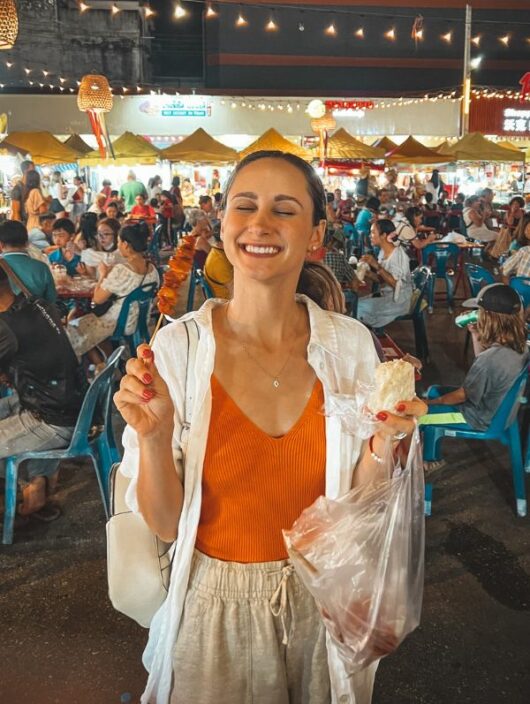
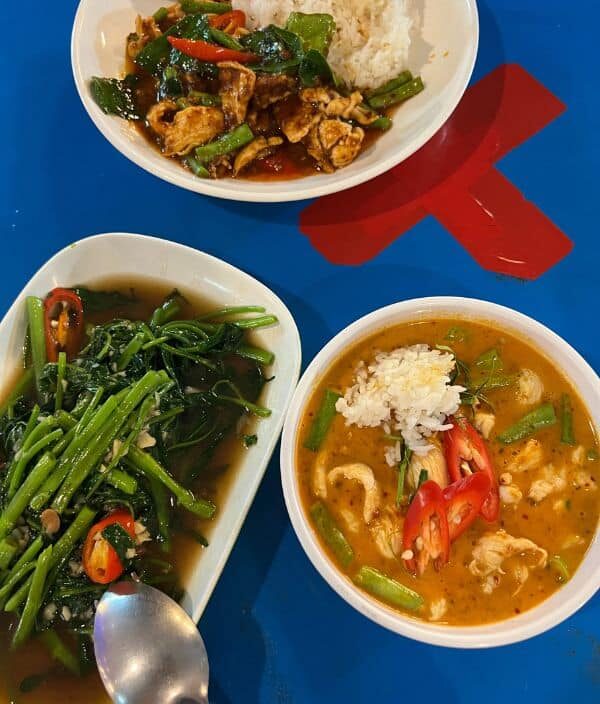
Day 2 in Bangkok
Experience the Maeklong Railway Market
Escape from the city on day 2 to check off one of the most memorable places you can visit during your trip to Bangkok.
The Maeklong Railway Market, located 1 hour south of Bangkok, is a one-of-a-kind market experience. The vendors set up shop right on the railway tracks – no safety barriers or warning lights in sight. At several intervals throughout the day, vendors quickly fold up their umbrellas and stalls to make way for the train, which passes through the core of the market!
It’s an adrenaline-inducing sight to behold as the train chugs through the narrow pathway, mere inches away from the vendors’ products. In fact, the train runs so close that you could reach out and touch it! When the train finally passes, the vendors just as quickly unfold their umbrellas and resume business as usual.
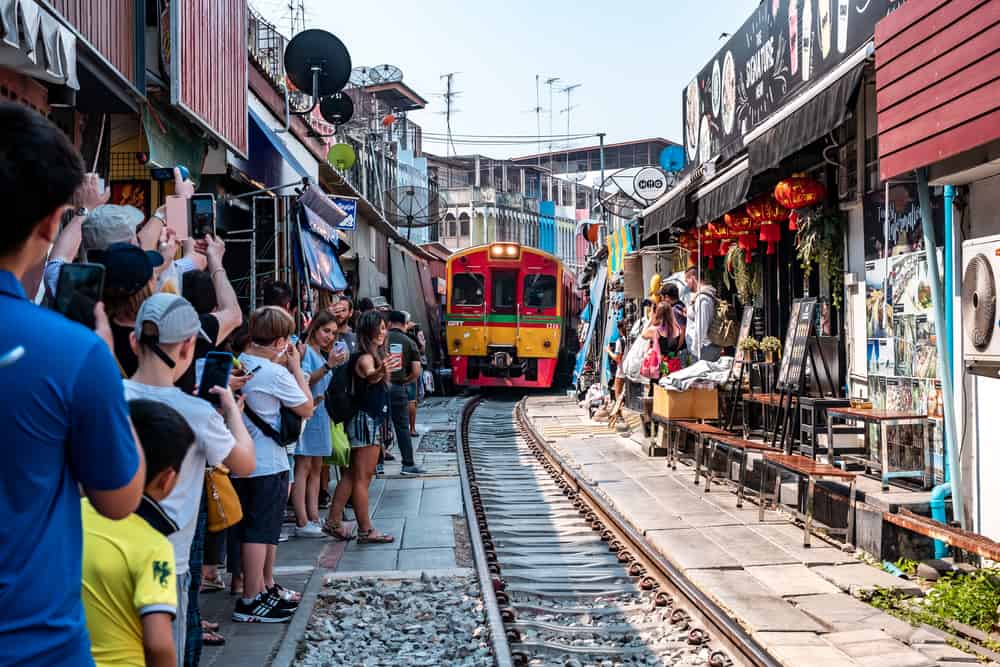
Keep in mind that the train only passes through at specific times, and if you want to catch it, you’ll need to arrive at least 15 minutes early to secure a spot along the tracks.
The train arrives daily at: 8.30 a.m., 11.10 a.m., 2.30 p.m., and 5.40 p.m, and departs at: 6.20 a.m., 9.00 a.m., 11.30 a.m. and 3.30 p.m.
Cruise Through a Floating Market
It’s time to make your way to yet another iconic site. Floating markets are special in that they are situated along rivers and canals where, traditionally, vendors would sell goods out of wooden boats on the water instead of stalls.
There are many floating markets around Bangkok, with the most popular one being Damnoen Saduak Floating Market. But if you’re looking for a more authentic experience, I suggest going to the lesser-known Amphawa Floating Market, which is also frequented by local Thais.
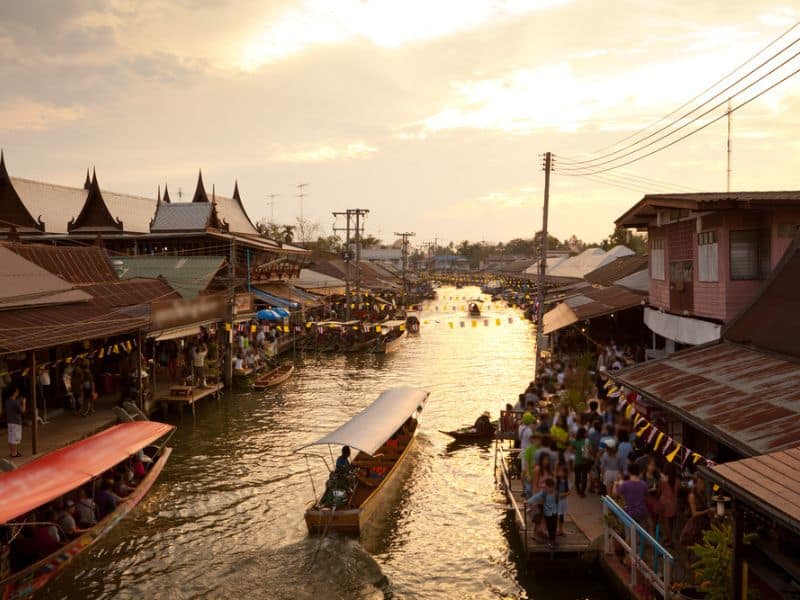
The main draw to the floating markets is, of course, the food! Grilled prawns, fish, and other seafood dishes are all carefully prepared on the wooden boats that glide along the canals. Do as the locals do and place your order with a vendor, and once your food is done, have a seat on the concrete steps leading down to the water to devour your meal.
If you prefer a classic table-and-chair setup, Amphawa Floating Market does have restaurants a bit further away from the main bridge. Some restaurants even have balconies overlooking the water, where you can enjoy your food with the backdrop of the market.
Muay Thai fight in the evening
When you arrive back in Bangkok, get ready for a glimpse into Thailand’s rich martial arts history by attending a Muay Thai fight. It’s a centuries-old martial art combining striking techniques with clinching and powerful kicks, and witnessing a fight in Thailand’s capital is an exhilarating experience.
The atmosphere inside the stadium is exciting, with cheering fans, loud music playing, and locals betting on which fighter will win. One of the coolest elements of the night will be the Wai Kru Ram Muay, a ceremonial dance during which the fighters pay homage to their teacher, parents, or King.
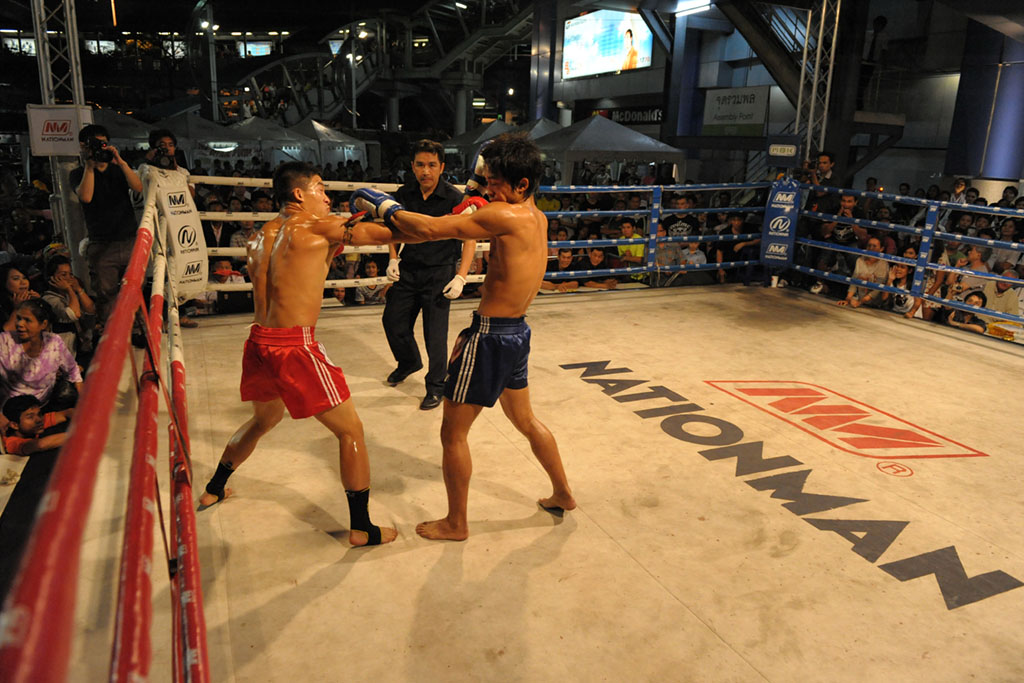
There are plenty of places to watch a Muay Thai fight in Bangkok, and many of these venues offer tickets that can easily be purchased online or at the door. Depending on the stadium, fights are only held on certain days of the week.
Check out Muay Thai Citizen for a complete list of venues and times for catching an authentic Muay Thai fight. You can also book tickets to a Muay Thai boxing match at Rajadamnern Stadium via GetYourGuide.
If you want to learn more about Muay Thai, you can even take classes at one of Bangkok’s many training centers.
Rooftop bar
You can’t go to Bangkok without enjoying the city’s stunning skylines from a rooftop bar. There’s something extra magical about sipping a cocktail high above the bustling streets, surrounded by the glittering lights and endless sea of skyscrapers.
Bangkok is a haven for rooftop bars, and each one offers a unique experience, from sleek and modern venues to hidden gems tucked away in charming corners of the city. Sip on refreshing mojitos, indulge in exotic Thai-inspired blends, or savor a perfectly crafted martini while admiring the panoramic views.
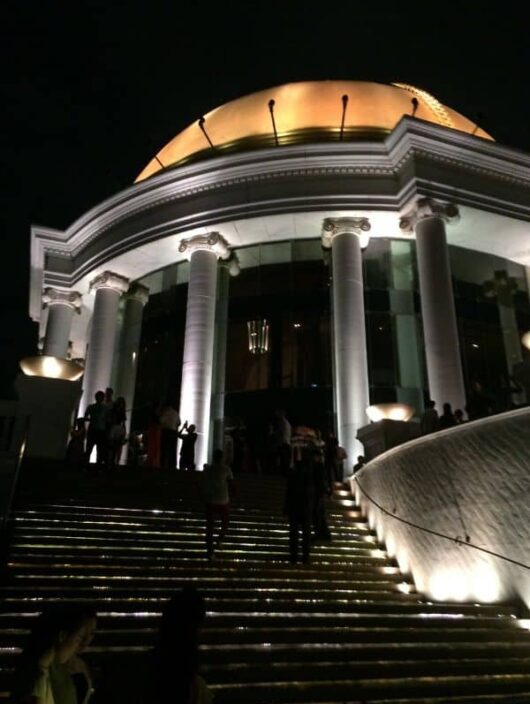
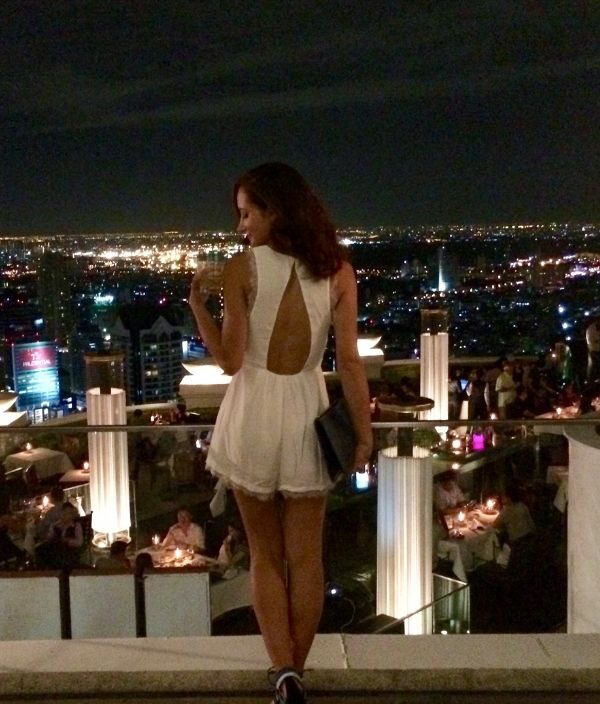
Some of my favorite rooftop bars in Bangkok are:
- Tichuca Rooftop Bar
- Octave Rooftop Lounge & Bar
- Eagle Nest Bar
- Skybar at Lebua State Tower, seen in The Hangover 2.
*Day 2 Alternate Itinerary
Day 2 on your Bangkok 4 days trip would ideally be a Saturday, as that is when the floating markets and Muay Thai fights take place.
If your visit does not fall on a Saturday, I suggest checking out Khlong Toei Market (map pin), which is one of the last authentic markets of Bangkok and a truly local spot.
Khlong Toei Market may not be an Instagram photo spot, but it shows what a true Thai market looks like. You’ll get a real taste of Thailand as you pass by stalls selling loads of fruits and vegetables, live frogs, obscene amounts of dried fish, crates of eggs stacked sky-high, and extremely fresh chicken (if you’re pickin’ up what I’m throwin’ down).
After your market visit, journey over to the west side of the Chao Phraya River for a Hidden Bangkok Bike & Food Tour. Your local guide will take you deep into the hidden, old Bangkok that 99% of tourists have never seen. This tour will have you traveling like a local while riding through narrow backstreets and stopping to eat tasty Thai food along the way.
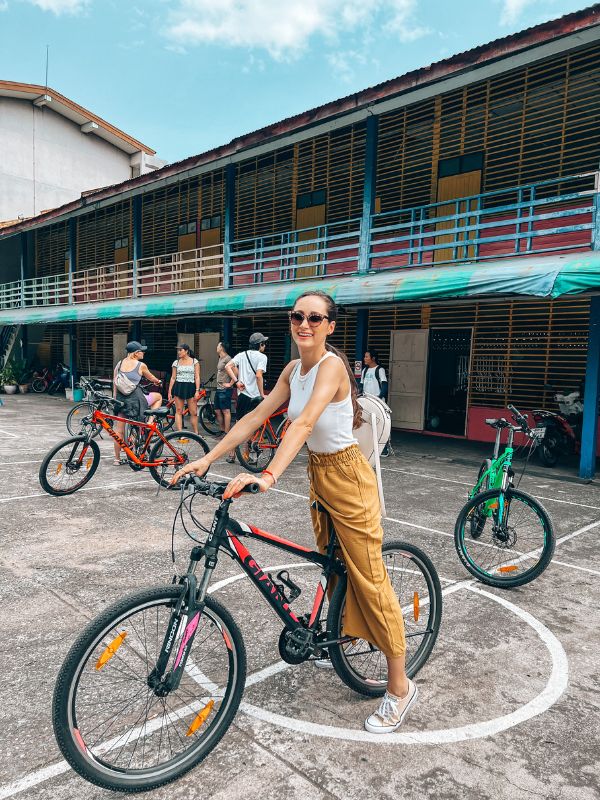
Day 3 in Bangkok
Stroll Through Bangkok’s Famous Parks
Begin the morning of your third day in Bangkok by making your way to the city’s most iconic green space, Lumpini Park (also spelled Lumphini Park). I recommend going early, between 7:00 AM and 9:00 AM.
Not only will it be cooler in the morning, but this is also the time when you will see the most people in the park. It’s fun to people-watch as locals go for their morning jog, partake in outdoor aerobics classes, and even practice dance routines.
Wandering through Lumpini feels surreal as the park is incredibly peaceful and lush, despite being smack dab in the heart of Bangkok and surrounded by skyscrapers.
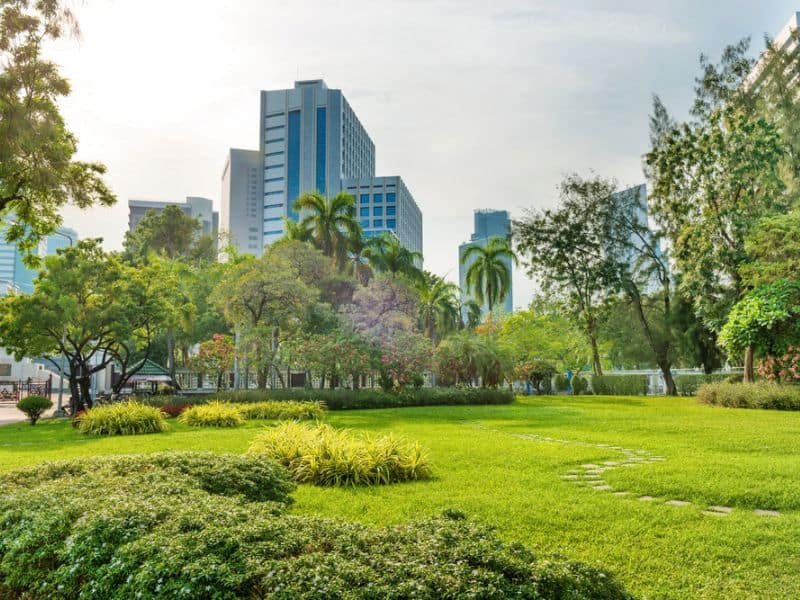
Walk around the large fish ponds to try and spot the humungous monitor lizards swimming, or find a seat in the shade to enjoy a take-out coffee from one of the countless cafes surrounding the park (or pick one up from 7/11!).
If you’re up for a bit more exercise, move through the park toward the northeast corner where you’ll find the entrance to the Lumpini-Benchakitti Park Walkway (also known as the Green Mile). This 2-kilometer stretch is a well-paved overpass that connects Lumphini Park to the newer and majestic Benjakitti Forest Park.
The path cuts through the city over roads and khlongs, giving you a glimpse into Bangkok’s daily life. From the verdant parks on either end to Thai homes crowded along the canals below, this pathway will completely immerse you in the authentic charm of Bangkok.
The path itself is separated into a walking lane and a bike lane, and there is even a small shop along the overpass where you can grab a refreshment from.
Shop at Chatuchak Weekend Market
After you’ve gotten in your morning exercise, it’s time to make your way to what is considered to be one of the largest markets in the world – the Chatuchak Weekend Market (map pin). This sprawling market is spread out over 35 acres and consists of no less than 15,000 stalls!
While it may seem overwhelming, the market is very well organized and easy to navigate – although it will take you several hours to make it through the maze of stalls if you want to see everything.
Anything that you can think of you can and will probably find at Chatuchak Weekend Market. You’ll see vendors selling handicrafts, souvenirs, antiques, wooden products, furniture, ceramics, clothing, footwear, accessories, and even pets.
Luckily, the market has plenty of food options for when you get hungry from all that shopping. While the market is outdoors, they have recently added an indoor, air-conditioned section where you can pop in and cool off. Chatuchak is popular with both locals and tourists and is open on Saturdays and Sundays from 9:00 AM to 6:00 PM.
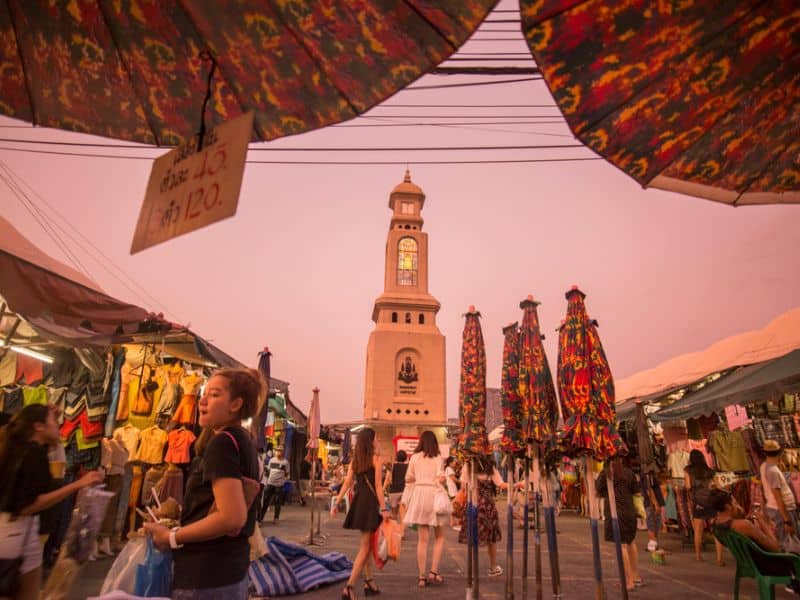
Explore Chinatown and the Talad Noi District
No trip to Bangkok would be complete without a visit to Chinatown. So to end day 3, take the MRT to Hua Lamphong station to explore the Talad Noi District first (map pin). This historic riverside neighborhood is still a bit under the radar, which makes visiting it that much cooler since not many tourists venture to this part of the city.
This primarily Chinese neighborhood is lined with repair shops and stores selling car parts. Tucked between these places are old temples, beautiful street art, and hip cafes housed in former factories and garages. It’s such an eccentric area of Bangkok, and definitely worth taking a stroll around.
Get your afternoon caffeine fix with a perfectly brewed coffee at Mother Roaster’s or grab a bite to eat at Hong Sien Kong Cafe (also a gorgeous spot to watch the sunset). While it can be fun to explore independently, you can also join this Bangkok Chinatown guided tour for the best cultural and culinary hotspots.
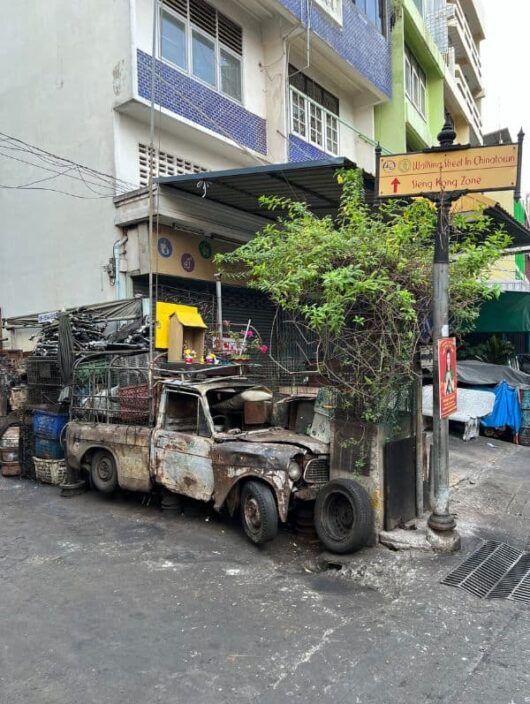
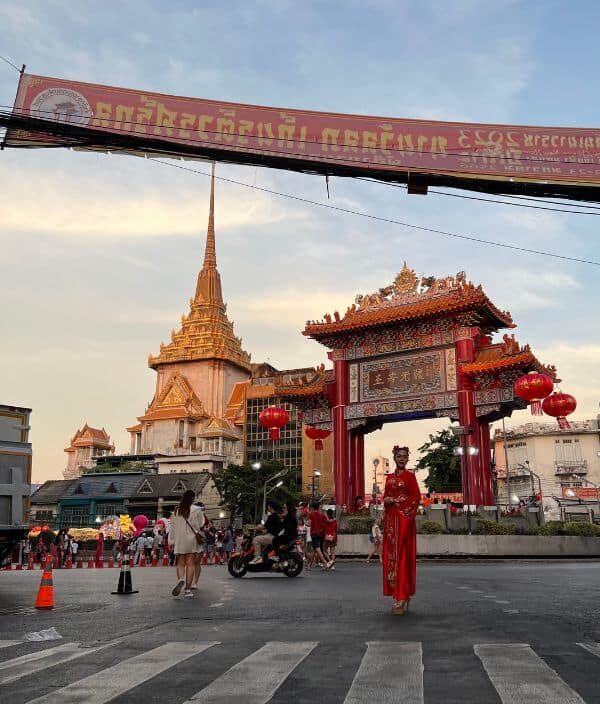
When night falls, walk over to Chinatown, one of Bangkok’s most vibrant districts. Chinatown is a melting pot of Chinese culture and Thai charm. Stepping into this bustling neighborhood, you’ll find yourself surrounded by a whirlwind of sights, sounds, and enticing aromas. It truly is a feast for the senses.
Make your way down Yaowarat Road, the main avenue that runs through Bangkok’s Chinatown. There, you’ll find an array of incredible street food, historical buildings, and lots of shopping opportunities (Yaowarat Road is also a great place to buy gold if you’re looking for a special souvenir).
You can walk all the way to Ong Ang Walking Street, one of Bangkok’s newest attractions. This area runs along both sides of the khlong “Ong Ang” and is decked out in string lights and interesting street art. The walking street also features live music, boating on the canal, a market, and of course, plenty of Thai food.
*Day 3 Alternate Itinerary
If your stay in Bangkok doesn’t align with a weekend, you unfortunately won’t be able to visit the Chatuchak Weekend market. But don’t worry, there are plenty of other things to do!
For instance, embark on a captivating journey into Thailand’s ancient history with a day trip to the ancient city of Ayutthaya. Built in 1350, served as the capital of Siam for several centuries before it was burned down in 1767.
Today, it is a UNESCO World Heritage Site, and remnants of the once-glorious city can be witnessed at the Ayutthaya Historical Park just a one-hour drive north of Bangkok. Strolling among the temple ruins will transport you into the past as you admire the intricate brick and stone architecture, towering prangs, and serene Buddha statues that have withstood the test of time.
You can get to Ayutthaya by train or bus, but joining this tour to Ayutthaya includes a hotel pickup and is the easier way.
Day 4 in Bangkok
Jim Thompson House
On the last day of your 4 day Bangkok itinerary, begin your morning at the Jim Thompson House. This historic house-turned-museum provides a fascinating glimpse into the life of Jim Thompson, an American businessman who played a pivotal role in reviving the Thai silk industry.
Surrounded by lush gardens, ponds, and tropical flowers, the Jim Thompson House is a peaceful oasis in the heart of bustling Bangkok. While touring the house, you’ll learn about Jim Thompson’s efforts in revitalizing the Thai silk industry, and how silk is produced, as well as view his impressive collection of Southeast Asian art and artifacts.
In the on-site shop you can find an extensive range of high-quality silk products (unlike the “silk” products you’ll come across at the markets). From scarves and ties to clothing and home decor items, the shop provides an opportunity to take a piece of Thai silk craftsmanship home with you.
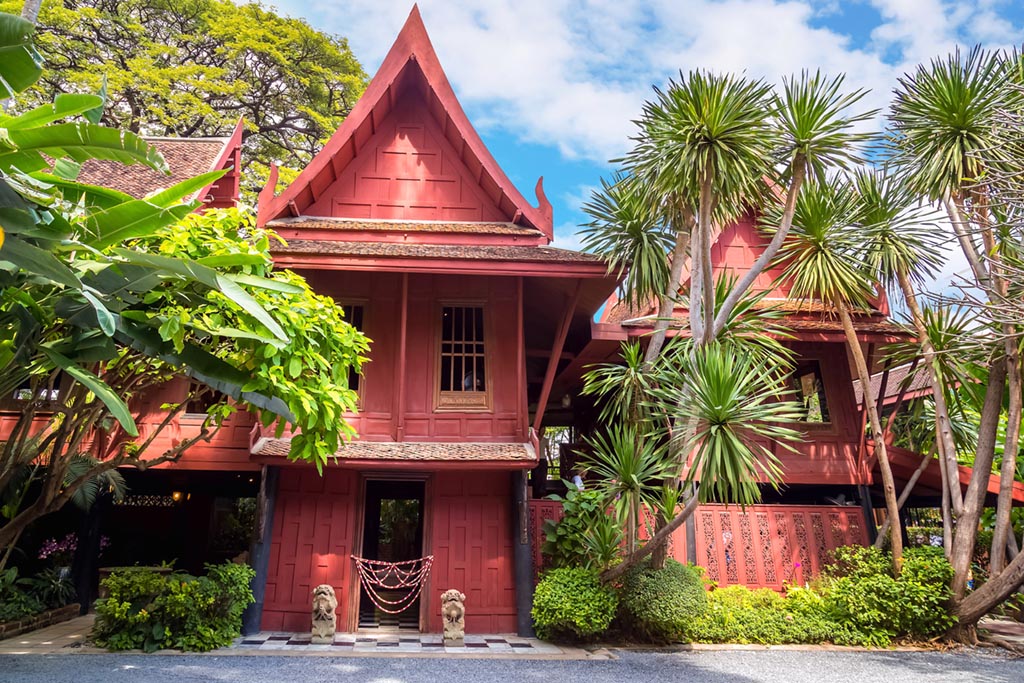
Go Shopping at Siam Square
Now it’s time to dive straight into Siam Square, one of Bangkok’s most dynamic and bustling shopping districts. Located in the heart of the city, Siam Square is known for its trendy boutiques, modern malls, and endless shopping options that cater to every taste and budget.
Head to Siam Paragon for a world-class shopping experience. From renowned international designers to exclusive Thai labels, you’ll find an array of stylish clothing, accessories, and lifestyle products to indulge in.
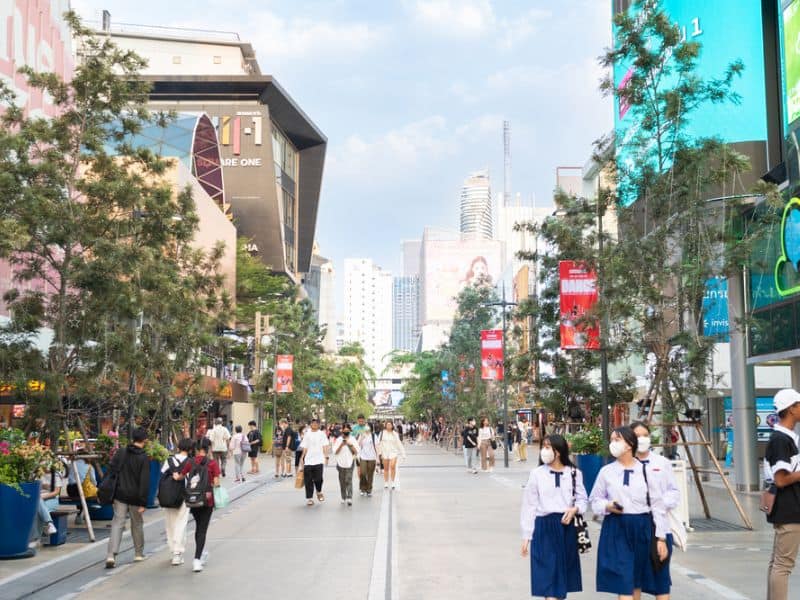
If you’re looking for a diverse range of shopping choices under one roof, head to MBK Center. This multi-story mall is a treasure trove of bargains, with countless stalls and shops selling everything from high-end dupes and accessories to electronics and souvenirs. This is a great place to score some good deals!
When in Siam Square, don’t miss the chance to stop into the 9th largest shopping mall in the world – centralwOrld. With over 500 stores spanning 8 stories, centralwOrld is a massive mall with a huge variety of stores and restaurants to choose from.
If you still have it in you after all that shopping, head across the river to ICONSIAM, one of the biggest malls in Asia that even houses the world’s only indoor floating market! You’ll find high-end stores here, a lovely terrace with panoramic views of the city skyline, and a fountain show in the evening.
Needless to say, ICONSIAM is quite the spectacle and is definitely worth the visit. Plus, you can get there for free using the ICONSIAM free shuttle boat that departs regularly from the Sathon Pier.
![]()
Party on Khao San Road
End the day by heading to the famous Khao San Road, the legendary backpacker hub of Bangkok. This tiny street is bursting with bars, buckets of cocktails, exotic street food, and loud music. It’s where you can enjoy a cold beer or cocktail while mingling with fellow travelers from around the world.
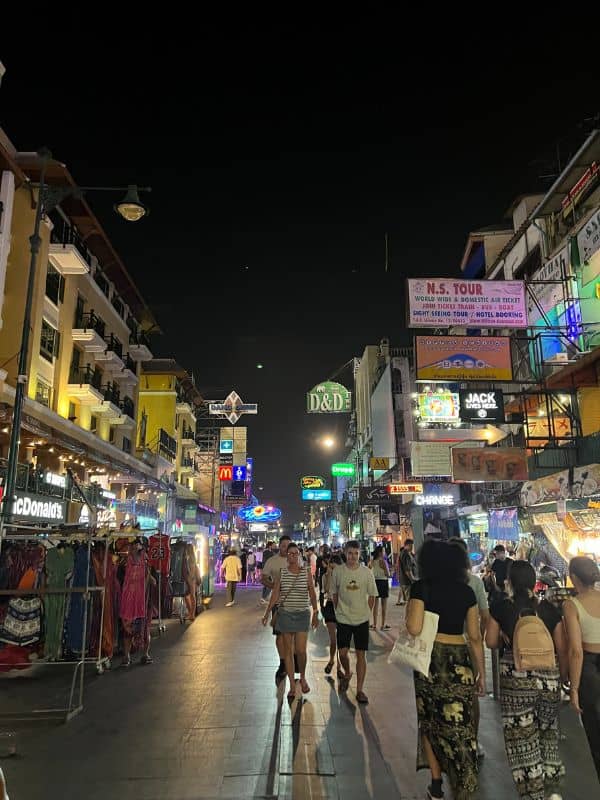
It is important to note that while Khao San Road is well-known for its lively atmosphere, it may not be for everyone.
The street can be crowded, noisy, and chaotic, so if that’s not your thing, you might have a better time on a Chao Phraya River Cruise. Several companies offer the opportunity to dine on a luxurious boat as you cruise past Bangkok’s illuminated historical landmarks. You can book this cruise on the Chao Phraya River.
While on the boat, you’ll enjoy live music, an international buffet, a cool breeze throughout the night, and spectacular views of Bangkok. The ride along the river lasts about two hours and is a wonderful way to end your 4-day Bangkok itinerary.
Other Things to Do in Bangkok
Have extra time in Bangkok? You can easily extend your itinerary with any or all of the following activities.
Take a Cooking Class
Immerse yourself in the flavorful world of Thai cuisine by joining a cooking class! Cooking With Poo is a class in Bangkok that offers visitors the opportunity to learn the art of Thai cooking from a remarkable woman named Poo.
Poo will take you to the local market to pick up ingredients and teach you about the different types of fruits, vegetables, herbs, and proteins used in Thai cooking. After that, you’ll head to Poo’s house where she guides you through the preparation of traditional dishes from aromatic curries to savory and sour soups.
Beyond the cooking experience itself, the class takes place in Klong Toey (Bangkok’s largest slum), giving visitors a chance to witness a different side of the city. It’s an eye-opening experience that goes beyond the typical tourist attractions and allows you to appreciate the richness and diversity of Thai society.
Visit Poo’s website to read more about her cooking school and book a class while you’re in Bangkok!
Alternatively, you can also join other cooking classes like this one.
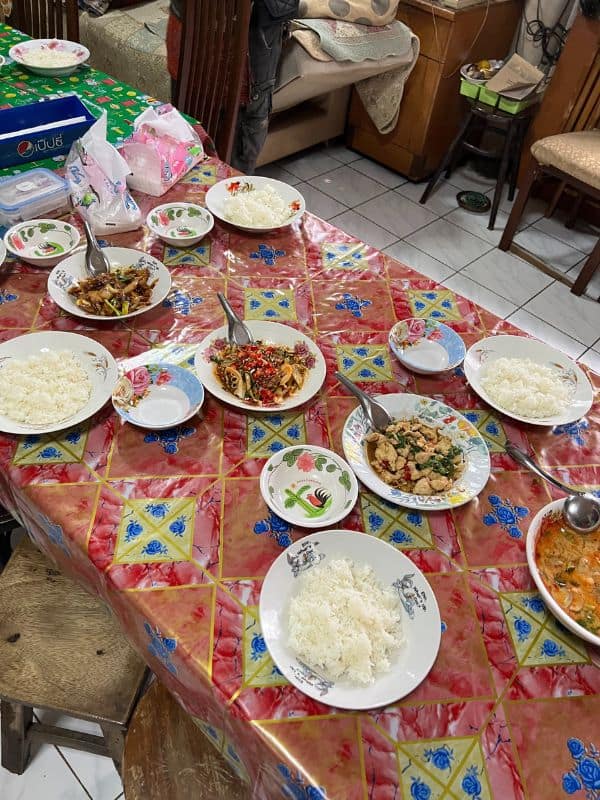
Erawan Museum
A few extra days in Bangkok will give you time to explore some unique sites beyond the city limits. One place that’s worth visiting is the Erawan Museum, located south of the city center (map pin).
This captivating museum offers a fascinating experience that combines art, culture, and spirituality. You’ll be able to easily spot it by its eye-catching architecture depicting a three-headed elephant statue that sits atop a pink building.
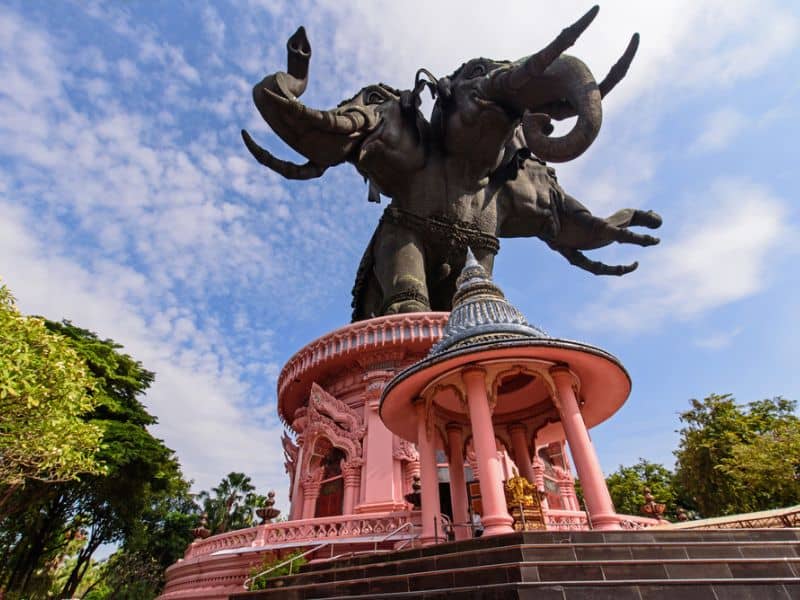
The gardens here are pleasant to walk through and you can enter the museum to walk up the intricate staircase leading up to the head of the elephant. The gorgeous stained glass ceiling inside also makes for some great Instagram photos!
To get to the Erawan Museum, take the BTS Green Line all the way to Pu Chao station. From there, you can take a taxi or a Grab for the remaining 1.3 kilometers to the museum.
Asiatique
If you’re looking for a spot that combines shopping, dining, entertainment, and stunning riverside views, then Asiatique (map pin) is the place to be. This open-air, riverside mall offers an extensive range of shopping opportunities from trendy fashion and accessories to unique handicrafts and souvenirs. But it’s not just about shopping – there’s so much more to explore here!
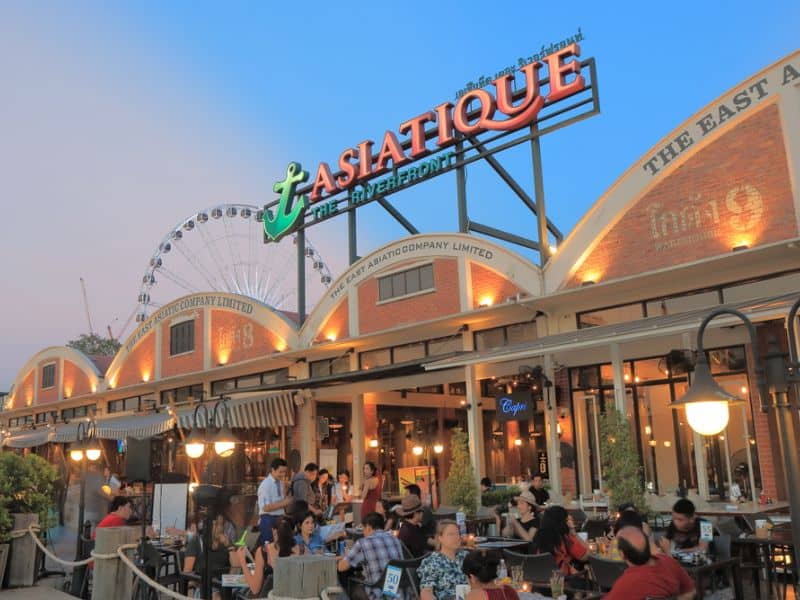
Take a ride on the iconic Asiatique Sky ferris wheel and be treated to breathtaking views of the cityscape and the glittering lights of Bangkok. This is the highest ferris wheel in Bangkok, reaching 60 meters in height, allowing you to truly soak up the skyline. Asiatique also has a merry-go-round and a haunted house ride, making it a fun place to come with children.
When you get hungry, choose from over 40 different restaurants and eateries, all serving up a variety of international dishes. As for entertainment, Asiatique offers a cabaret show, a puppet theater, and a Muay Thai show.
Even if you don’t buy anything, Asiatique is a wonderful place to go for a leisurely evening walk as there is always something fun going on here.
Bang Krachao (Bangkok Green Lung)
Bang Krachao (sometimes spelled Bang Kachao) is an artificial island in the middle of the Chao Phraya River (map pin). This urban jungle is relatively unknown to tourists but is a hidden gem worth exploring for adventurous travelers.
Just a short 2-minute ferry ride away from Bangkok, Bang Krachao offers a refreshing escape from the hustle and bustle of the city. With its lush greenery, peaceful canals, and cycling-friendly paths, this oasis is a paradise for nature lovers.
Trust me when I say that you’ll forget you’re in one of the busiest cities in the world!
When you arrive in Bang Krachao, you can rent a bike right at the pier for only 50 baht an hour. Pedal your way through the leafy pathways, passing by traditional wooden houses, fruit orchards, and serene temples. You can join this Bang Krachao Island bike tour, which includes a visit to the Khlong Toei Market.
A few places worth stopping at include the Sri Nakhon Kuenkhan Park, the iconic Bangkok Tree House, and the famous Bang Nam Phueng Floating Market.
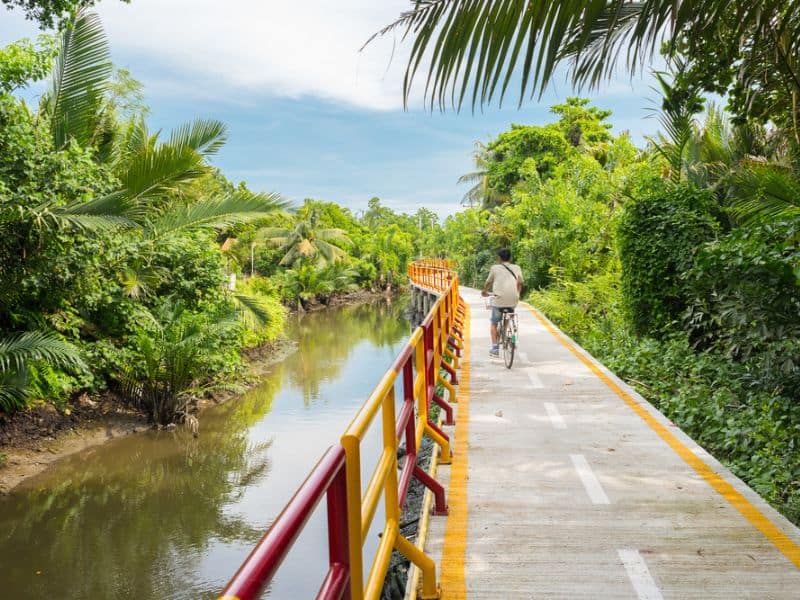
Kanchanaburi Day Trip
Located just a few hours away from Bangkok, Kanchanaburi is an ideal destination for a day trip, offering a mix of history, natural beauty, and cultural attractions. This province gained international recognition thanks to the movie “The Bridge on the River Kwai,” which immortalized the infamous World War II railway bridge and the harrowing events surrounding its construction.
Today, visitors can walk across the historic bridge, learn about its dark past at the nearby museums, and pay tribute to the lives lost during the war. In addition to its historic significance, the Kanchanaburi province boasts epic landscapes and serene surroundings including Erawan National Park.
You can reach Kanchanaburi from Bangkok by taking one of the many day trips offered to the region. Alternatively, you can organize this trip on your own for less by taking the train from Bangkok to Kanchanaburi. It runs twice per day and departs from the Bangkok Thonburi station. This standard, commuter-style train has bench seating and the journey takes about 2.5 hours to reach the station in Kanchanaburi.
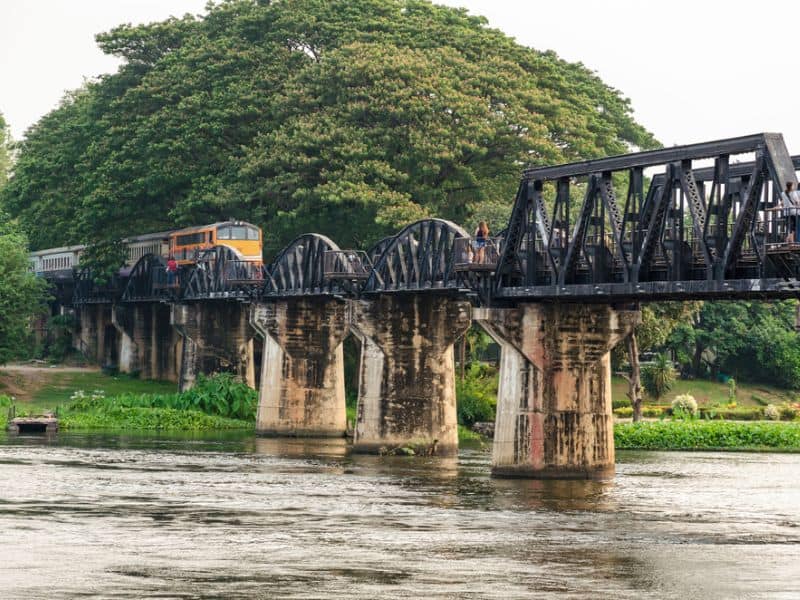
Travel Tips for Bangkok
When to Visit
There is no real “best” time to visit Bangkok as it is a year-round destination, so the best time will really depend on your personal preferences. Bangkok does, however, have three main seasons which are: Hot Season (from March to June), Rainy Season (from July to October), and Dry Season (from November to February).
The Cool Season (November to February) is widely considered the best time to visit Bangkok. The temperatures are pleasant, and the humidity is lower, making it more comfortable for outdoor activities. Because the Cool Season is so popular, it is also the most expensive time to visit.
On the other hand, if you’re comfortable with higher temperatures or want to take advantage of lower prices, the hot or rainy seasons can still offer a rewarding experience.
Where to Stay
Each neighborhood in Bangkok has its own unique character and attractions.
If you’re looking for a central location with easy access to major attractions and shopping, you might consider staying in the bustling areas of Sukhumvit, Silom, Siam Square, or Sathorn. These neighborhoods offer a wide range of accommodation options, from luxury hotels to budget-friendly guesthouses, and are known for their lively nightlife, malls, and diverse dining scenes. They are also the most touristy areas in the city but are well-connected to all of Bangkok’s main sites by the BTS and MRT.
Backpackers and budget travelers will likely enjoy staying at one of the many cheap hostels and accommodations in the Khao San Road area. If you do choose to stay here, you should be aware that there are no BTS or MRT lines that connect this neighborhood to the rest of the city. Your main modes of transportation will be limited to taxis, tuk-tuks, and walking.
If you prefer staying outside of the tourist bubble, try the areas of Ari, Thonglor, or Phra Kanong.
The best way to find hotels in Bangkok is to search Agoda, the most popular booking platform in Asia.
Below are several options for accommodation in Bangkok, ranging from ultimate luxury to budget-friendly finds.
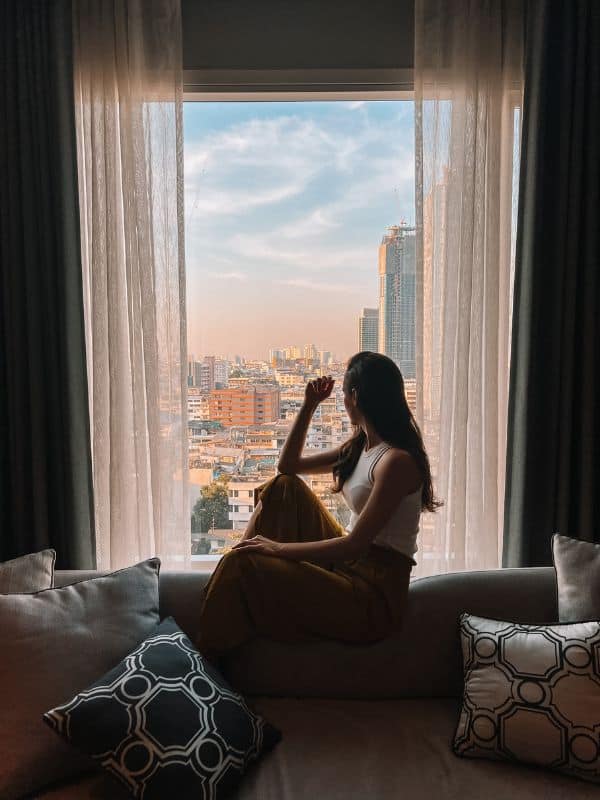
Budget
If you’re on a budget but don’t want to sacrifice comfort and cleanliness, look no further than the Tropical Summer Cafe & Hostel. It’s located in a quiet location just a 12-minute walk away from the Saint Louis BTS station. The hostel boasts a gorgeous rooftop terrace and plenty of community living areas where you can meet other like-minded travelers.
Mid-Range
Located in the Phra Kanong neighborhood just off of Rama IV, the Jasmine Grande Residence is a great place to stay in Bangkok for those looking to escape the tourist hot spots. The rooms here are clean and spacious, making them ideal for families or anyone who just likes to have a little more room when traveling.
I stayed here a few times and have always had a pleasant stay! The staff is wonderful, the breakfast is solid, and the hotel is within walking distance to the Phra Kanong BTS station. It is also close to the W District Community Mall and W Market, an open-air food court with lots of different international food options including Japanese, Mexican, and Italian.
Luxury
For a truly indulgent experience, consider high-end properties like The Mandarin Oriental or The Peninsula Bangkok, where you’ll be treated to top-notch amenities and breathtaking views of the Chao Phraya River.
Other 5-star stays worth considering include the Banyan Tree Bangkok, a stunning oasis in the Sathon/Silom area with an insane rooftop bar, or Bangkok Marriott Hotel the Surawongse, a gorgeous property in Bang Rak.
As Marriott Bonvoy members, my partner and I recently stayed at The Surawongse and let me tell you – it was absolutely incredible. The staff was lovely, the interior was beautifully decorated in the perfect blend of traditional Thai and contemporary style, the lobby smelled heavenly, and the views from the rooftop pool were to die for. See what I mean in the photo below!
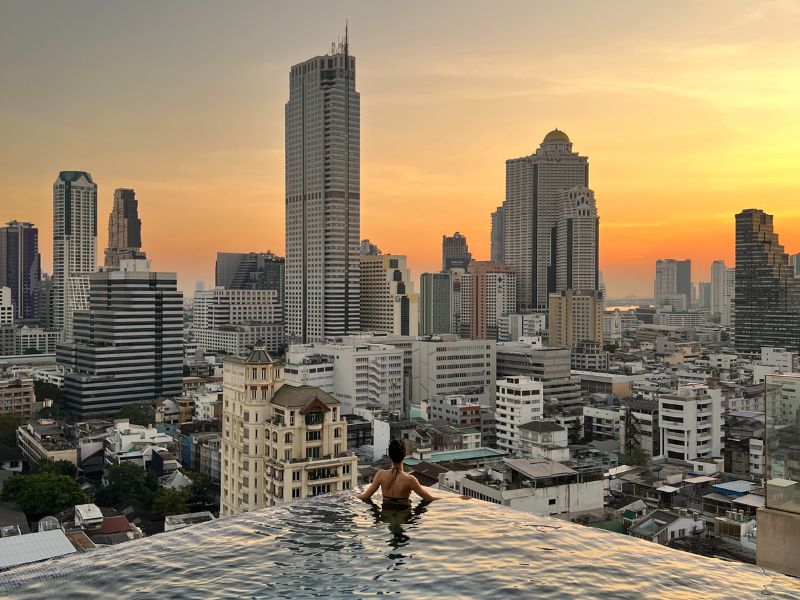
If you want to stay at The Surawongse, sign up for the Marriott Bonvoy card to get three free nights when you meet the minimum spend.
Getting Around
Despite its vast size, navigating Bangkok is surprisingly convenient and budget-friendly, thanks to the city’s extensive transportation options. Whether you’re a first-time visitor or a seasoned traveler, you’ll find it relatively easy to get around and explore.
The cheapest, and most efficient options will be Bangkok’s excellent public transportation system. Depending on your current location and where you want to go, you can choose between the BTS Skytrain or MRT subway. The MRT circles around the city center, while the BTS lines run in several different directions, occasionally intersecting with the MRT.
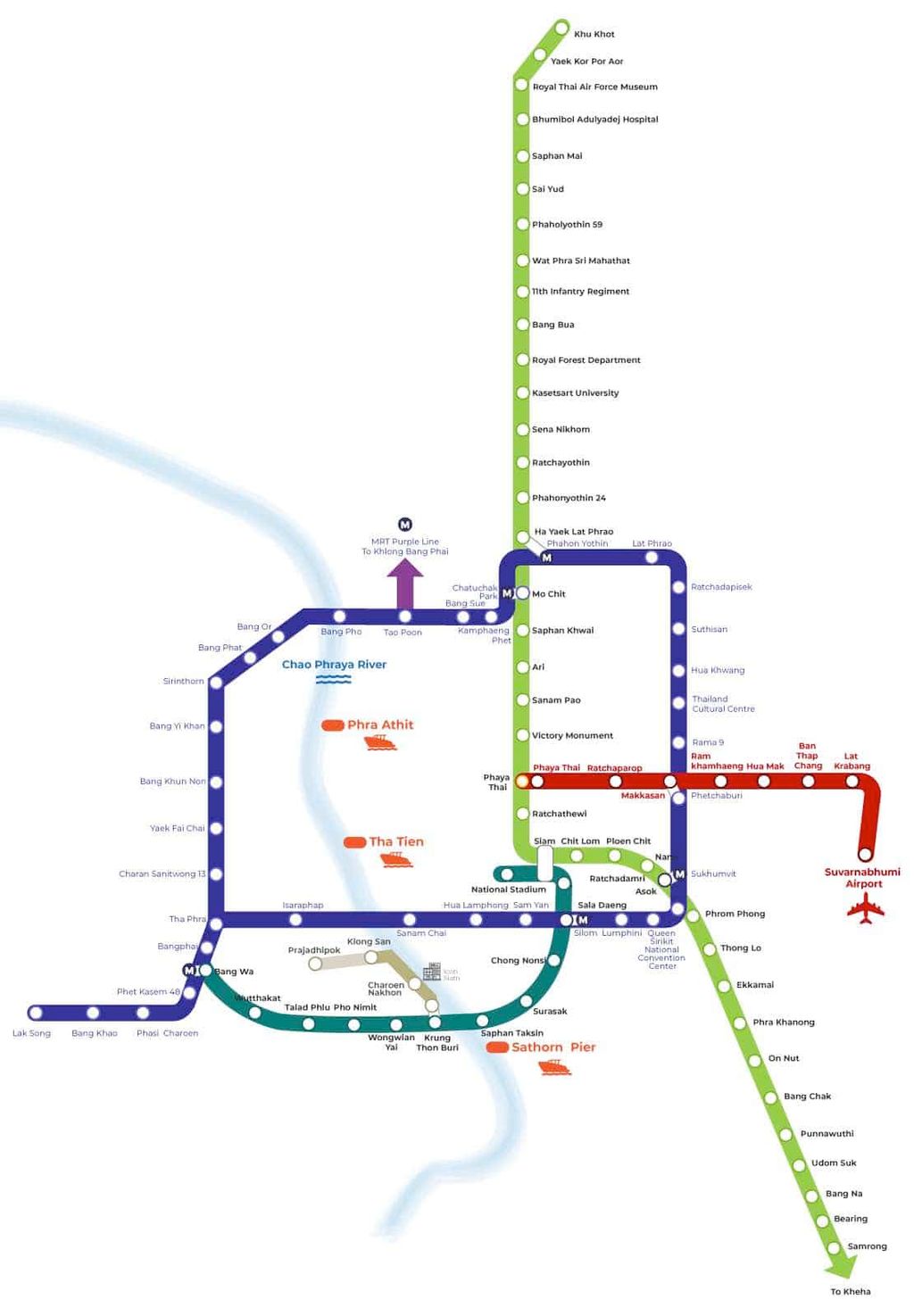
Fares for the BTS and MRT are charged by distance, although most rides will cost you less than $1.00. It is important to know that tickets for the BTS and MRT are not interchangeable (you will get a paper ticket for the BTS and a plastic token for the MRT).
Another fast and easy way to get around is to use the canal boats which are inexpensive and run every 5-10 minutes.
Finally, you can get around via tuk-tuk or taxi. These last two options will be the most expensive, and depending on traffic, take the longest.
Tuk-tuks tend to be pricier than taxis, but that’s mostly because they are a tourist attraction (and are actually a lot of fun to ride).
These three-wheeled vehicles, often adorned with colorful decorations, can navigate through narrow streets and offer a unique way to immerse yourself in the bustling cityscape. There are no posted rates for tuk-tuks, so be sure to negotiate with your driver before taking a seat.
Taxis provide a good option for getting around and are convenient in the sense that you don’t have to worry about getting off at a certain stop or switching to another BTS or MRT line.
If you do decide to take a taxi, make sure it is metered before getting inside. I’d actually suggest downloading the Grab Taxi app, which will allow you to preview the price and time it will take you to reach your destination.
With such a wide range of transportation options available, exploring Bangkok on a budget is a breeze. Whether you choose to ride the efficient Skytrain, navigate the canals, or go on a tuk-tuk adventure, you’ll find that getting around the city will be an exciting part of your Bangkok experience.
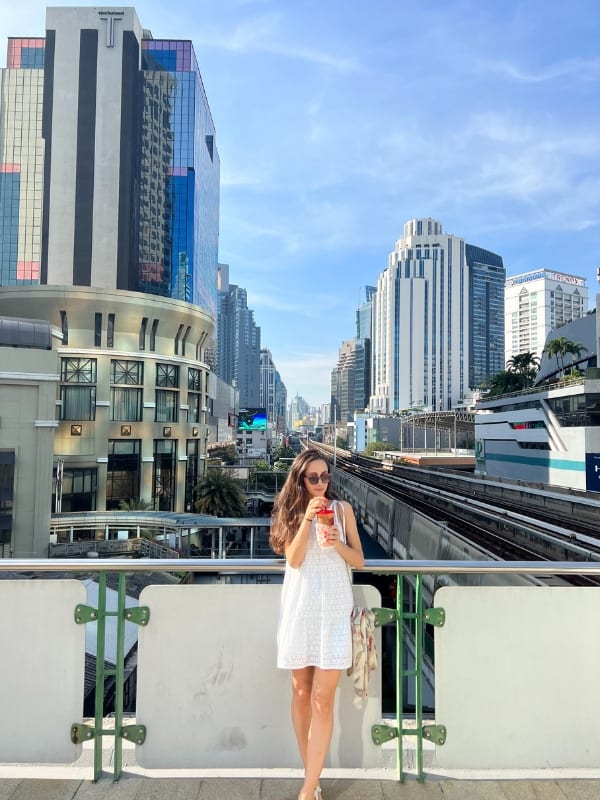
Are you ready to embark on an unforgettable adventure in Bangkok? Then pin this post or bookmark it and use it as your roadmap for a truly extraordinary 4 days in Bangkok.
The author Olivia has visited and lived in Bangkok, letting her experience the city known as The Big Mango like a local. She currently blogs at Inspired by Croatia.
Some links may be affiliate links, meaning I may earn commission from products or services I recommend. For more, see site policies.
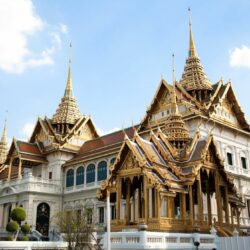
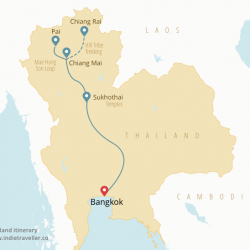




0 comments
Leave a comment
Your email address will not be published. Comments are manually moderated.